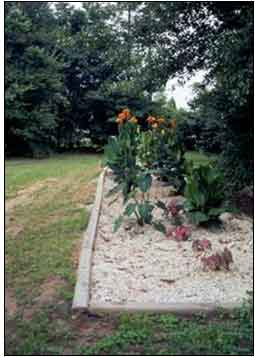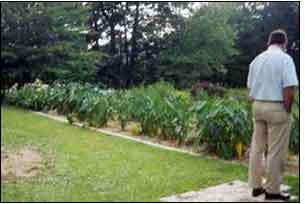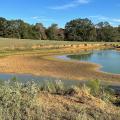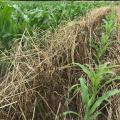Greywater Gardens
 Reusing wastewater on planted areas is nothing new to agrarian cultures. It is documented that English and German farmers have used wastewater as fertilizer from as early as the 16th century. Early Greeks did the same thing, as did many Asian countries even before the days of Plato.
Reusing wastewater on planted areas is nothing new to agrarian cultures. It is documented that English and German farmers have used wastewater as fertilizer from as early as the 16th century. Early Greeks did the same thing, as did many Asian countries even before the days of Plato.
Disease problems associated with wastewater, including pathogenic bacteria and viruses, occurred primarily through direct contact with human waste in cities. Environmental pollution problems also occurred as excessive amounts of wastewater from growing populations overloaded nearby water bodies. Despite this misuse, human culture, plants and soil microbes have had a long-standing mutual and symbiotic relationship.
The Miracle of Soil Microbes
Far below the thin wiry leaves of the cattails, rushes and reeds of our planet's wetlands, tiny microbes are hard at work. These living powerhouses churn enormous amounts of organic materials from the dark soupy waters into useful nutrients that are absorbed by the roots of plentiful wetland plants. Natural wetlands do an important job of cleansing organic wastes from water supplies.
Adapting this natural process to human technology to cleanse water is referred to as phytoremediation, rock-reed filter systems, greywater systems, blackwater systems, biological treatment areas, or constructed wetlands.
Greywater is defined as any domestic wastewater produced including dish, shower, sink and laundry water, and all water except for sewage. Sewage, also known as blackwater, has a much larger organic load and is more strictly regulated for treatment by most health departments. Always check with your local health organization to see which systems are approved for use in your area.
Compared to blackwater, greywater usually contains less nitrogen, fewer pathogens, and breaks down in the environment much faster. Because of these factors, greywater systems are not as likely to cause severe water pollution. These natural technologies are being designed into residences, schools and offices, and even industries. There are several ready to install greywater treatment systems available to the home consumer.
 Why reuse Greywater?
Why reuse Greywater?
Greywater makes up between 50-80% of the average total volume of water used at home. In many areas of the country that are facing severe water shortages, greywater is an attractive alternative to reuse outdoors for watering ornamental planting beds or lawns. Water shortages are projected to increase nationally with the growing demands for fresh water resources across the nation. Recycling used residential water reduces the amount of treated fresh water needed by communities, lessens the volumes of water to be cleaned at treatment plants, saves on energy, recharges dwindling groundwater supplies, enhances plant growth, and reuses vital nutrients. And greywater systems are effective at cleansing wastewater. A 2002 report by the Massachusetts Department of Environmental Protection concluded that the use of greywater filters in combination with subsurface disposal had considerable benefits in regards to water purification.
How Greywater Systems Work
Although there are several different types of greywater treatment systems, there are a few components common to all. These systems consist of a settling tank, lined treatment cells filled with sand or rocks and wetland plants, and an outflow for the treated water for storage or deposition into the ground.
The settling tank serves a vital role in reducing any solid materials from entering the treatment cell to prevent clogging and helps to reduce the organic load. Anaerobic bacteria in the tank break down solids and many pathogens at this stage of the treatment process. Liquids from the tank then flow into the treatment cells that provide the next level of wastewater treatment. Several containment cells are used to further treat the water until the organic load is cleansed.
The first treatment cell is lined with an impermeable material such as plastic or rubber to prevent leakage into the surrounding soil. Filled with sand or rocks and planted with wetland plants, the size of the treatment area varies according to the amount of the organic load to be cleansed and the rate of the water flow. As wastewater slowly travels through the filter bed, microbial bacteria break down the available organic material. PVC water pipes connect the various treatment cells and use gravity flow of water or mechanical pumps to move the water from one cell to the next. The second and third treatment cells can be unlined (depending upon the soil type) and continues to provide further cleansing. Treated water from the cells then flows to a field drain absorption zone or outflow area.
Treatment cell maintenance
All greywater treatment cells need to be periodically maintained. If mechanical filters, screening devices, or pumps are used, these will need to be checked and cleaned on a regular basis to prevent obstructions.
Settling tanks need to be checked annually for proper decomposition of solid materials. The vegetation growing in the treatment cells must be herbaceous (non-woody vegetation such as iris, cattail, rushes, grasses or reeds). Roots from woody plants including shrubs and trees can penetrate through the treatment cell walls and must be discouraged or removed.
Also, gravel or sand beds can clog from fine particulate matter settling in and may have to be removed and replaced periodically if obstructed. As with any grey water system, household cleaners, detergents, and shampoos must be environmentally friendly.
Recommended plant species for use in greywater systems
Many wetland plant species are well-suited for planting in filter systems. It is important to gauge the average water level of the treatment cells in order to determine the plant types that will be most successful. If the water level stays at or near the surface of the gravel filter system, moisture-tolerant plants are best suited. If there is a wide fluctuation of average water levels throughout the year, drought tolerant plants such as grasses and reeds may be a better choice.
The following is a list of moisture-tolerant plants that have proven to be successful in greywater gardens.
| Common name | Botanical name | Characteristics |
| Arrow arum | Peltandra virginica | Large tropical leaf, shade tolerant, 3' height |
| Giant bulrush | Scirpus californicus | Grows to 10' tall, spreads by runners |
| Soft rush | Juncus effusus | Dark green reed, grows to 4' in height |
| Cattail | Typha latifolia | Showy flower spikes, grows to 8' tall |
| Butterfly ginger | Hedychium coronarium | White summer flowers, grows to 6' |
| Maidencane | Panicum hemitomon | Short grass that grows to 2' tall |
| Panic grass | Panicum virgatum | Tall grass to 6, summer seed stalks |
| Pickerel rush | Pontederia cordata | Blue summer flowers, grows to 4' |
| Common reed | Phragmites communis | Large reed that grows to 12' |
| Powdery thalia | Thalia dealbata | Blue/violet summer flowers, to 6' |
| Louisiana iris | Iris spp. | Various spring blooming species |
| Blue flag iris | Iris virginica | Blue spring flower, grows to 4' |
| Marsh mallow | Hibiscus lasiocarpus | White summer flowers, grows to 4' |
| Horsetail | Equisetum hyemale | Vertical reed that grows to 6' |
| Goldenclub | Orontium aquaticum | Yellow spring flowers, attractive leaves |
| Spider lily | Crinum americanum | White spring flowers, to 3' |
| Swamp lily | Hymenocallis occidentalis | White spring flowers, to 3' |
| Texas star hibiscus | Hibiscus coccineus | Red summer flowers, to 8' |
| Lizards tail | Saururus cernuus | White spring flowers, to 3' |
References: Wolverton, B.C. Growing Clean Water. Picayune, MS: WES, Inc. 2001.
These factsheets were written by Robert F. Brzuszek, Assistant Extension Professor, The Department of Landscape Architecture, Mississippi State University.
Publications
News
Mississippi growers and those across the Midwest and mid-South still have time to take advantage of two opportunities to improve soil health and water quality while protecting profitability on their farms.
Despite several recognized benefits of growing winter cover crops, this conservation system has limited acceptance, something Mississippi State University researchers are trying to change by identifying and better managing risks.
Among the significant benefits of planting a green crop on farmland otherwise exposed to winter elements are improved soil health, water quality and erosion control. But cover crops grow into the optimal spring planting times for summer crops. This complicates their use and can reduce productivity of the summer crop.
For the last several years, MSU research has addressed various aspects of this issue, primarily focusing on cover crop management and cover crop species.
Success Stories
Fenton Pope looked around his native Covington County a quarter-century ago and saw what he believed was an alarming amount of farmland out of production.
Billy Mitchell spent his childhood summers in the water and has lived at Pelahatchie Bay for more than three decades, so his dedication to protecting water resources now almost makes too much sense.
Cruising into Madison County, you see a cultivated urban landscape full of brick edifices and manicured lawns spring up around you. Your cell phone announces your turnoff, and you comply, turning onto an older road that soon turns to gravel.





